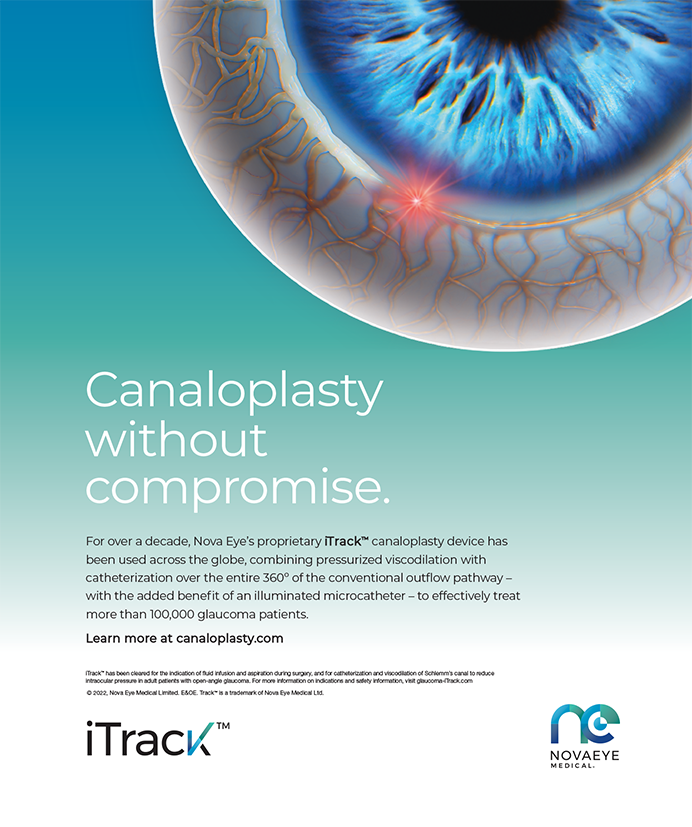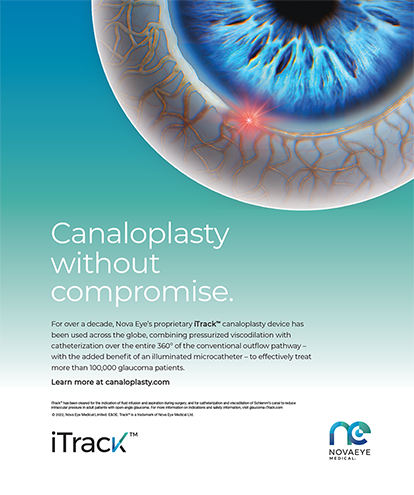Cover Stories | Jul 2005
Corneal Dystrophies
The role of the TGF-ß1 gene.
Anthony J. Aldave, MD
With the identification of the genetic basis of a number of corneal dystrophies, clinicians have been given the opportunity to definitively differentiate between inherited and degenerative corneal disorders that share common clinical manifestations. The screening of such disease genes in the younger relatives of affected patients allows the identification of those who carry the mutation and will develop the disease. Additionally, understanding the molecular basis of the corneal dystrophies not only provides insight into the genetic maintenance of corneal clarity, but it is an essential first step in developing treatment strategies based on genetic modification.
IDENTIFICATION OF TGF-ß1
In 1994, Stone and colleagues1 performed linkage analysis of four families with combined granular-lattice corneal dystrophy known as the Avellino form that demonstrated evidence of linkage to chromosome 5. Additional linkage analysis in two families with lattice corneal dystrophy and two with granular corneal dystrophy demonstrated significant linkage with the same markers. Thus, the investigators mapped the gene involved in each of these three stromal dystrophies to the long arm of chromosome 5. Three years later, Munier et al2 published their findings of missense mutations in the TGF-ß1 gene in patients with corneal dystrophy of Bowman's layer type I (or Reis-Bücklers corneal dystrophy), granular corneal dystrophy, lattice corneal dystrophy, and combined granular-lattice corneal dystrophy. They confirmed a common genetic origin for these clinically distinct corneal pathologies.
TGF-ß1 PROTEIN
Relation to Corneal Dystrophies
The protein product of the TGF-ß1 gene, referred to by some as keratoepithelin, is also known as TGF-ß1 protein (or TGF-ß1p). It is a prominent protein in the cornea, skin, and matrix of many connective tissues and appears to be an important structural component. Klintworth et al3 have shown that antibodies to this protein react with the characteristic stromal deposits in patients with granular corneal dystrophy. Additionally, Kawasaki et al4 reported that an antibody to the keratoepithelin protein demonstrates a pattern of immunoreactivity that closely mirrors the distribution of the stromal amyloid in patients with lattice corneal dystrophy type IIIA. Similar work5 demonstrated that the Bowman's-layer deposits in corneal dystrophy of Bowman's layer type I exhibit strong immunolabeling with a similar antibody to TGF-ß1p. Each of these investigations indicates that TGF-ß1p is a major component, if not the primary component, of the corneal deposits that characterize each of the TGF-ß1 dystrophies.
Distribution and Proposed Function
TGF-ß1p is expressed in normal corneas and is diffusely distributed throughout the corneal stroma, although it is most densely concentrated in the subepithelial zone.6 Upon examination of younger patients with TGF-ß1 corneal dystrophies, the deposits are typically superficial and tend to migrate posteriorly with time. Similarly, following a penetrating keratoplasty or phototherapeutic keratectomy for a TGF-ß1 dystrophy, the recurrent dystrophic deposits are initially noted in the subepithelial region.7 Because keratoepithelin is a major component of these deposits, it is proposed that the TGF-ß1p diffuses into Bowman's layer and stroma from an epithelial source, giving rise to Bowman's layer and stromal dystrophies that are actually of an epithelial origin.6,7 Sequence homology between TGF-ß1p and an insect cell-adhesion molecule have led investigators to propose a similar role for the protein in the cornea, although this has not been confirmed.8,9
PENETRATING LIMBOKERATOPLASTY
The proposed epithelial genesis of the TGF-ß1 dystrophies led Sundmacher and colleagues10 to propose a technique termed penetrating limbokeratoplasty for decreasing the recurrence rate of the TGF-ß1 dystrophies following corneal transplantation. The technique is performed by trephinating an eccentric donor button, such that 40% of the graft's circumference contain donor limbal stem cells. Transplanting this donor button to the recipient is intended to provide not only a clear central cornea, but also healthy donor limbal stem cells that produce the wild-type TGF-ß1p that will facilitate the maintenance of a clear central cornea. The investigators have indeed demonstrated a decreased recurrence rate for lattice corneal dystrophy and granular corneal dystrophy when compared with standard penetrating keratoplasty, as well as long-term survival of donor-derived epithelial cells in nearly one-half of the patients. One of the limitations of this technique, however, is the need for systemic immunosuppression to decrease the risk of immunologic rejection of the highly antigenic donor limbal tissue.
CLASSIFICATION OF TGF-ß1 DYSTROPHIES
The TGF-ß1 dystrophies have traditionally been classified according to the anatomic level of involvement (Bowman's layer and stromal dystrophies) and the clinical and histopathologic characteristics of the corneal deposits. However, the description of TGF-ß1 dystrophies that involve both Bowman's layer and the stroma, as well as corneal degenerations that share common phenotypic features with the TGF-ß1 dystrophies, have led several experts in the field to propose genetically based classification schemes. Although several of the genetically based classification systems are quite comprehensive,11 the subdivision of each TGF-ß1 dystrophy based on the underlying mutation may prove to be excessively cumbersome as more and more novel mutations are identified in the TGF-ß1 gene. I prefer a system that divides the TGF-ß1 dystrophies into only two categories, the classic and variant. The classic dystrophies are associated with the typical or characteristic phenotype one learns during residency training, and they are associated with a conserved number of mutations.12 In fact, the causative mutations occur at only two hotspots (codon 124 in exon 4, and codon 555 in exon 12). The genetic basis for most corneal dystrophies encountered by the clinician and sent to the geneticist for TGF-ß1–gene screening will be associated with a mutation at one of these two hotspots. Furthermore, diagnostic laboratories typically perform screening only for mutations at these two loci.
In contrast to the classic dystrophies, the variant corneal dystrophies often demonstrate an atypical phenotype and are associated with a large number of causative mutations, thus far identified in five of the 17 exons of the TGF-ß1 gene.11 Screening of the TGF-ß1 gene for these less common mutations is typically performed solely by research laboratories and only after the hotspot mutations have been ruled out.
SIGNIFICANCE OF identifying TGF-ß1
GENE IDENTIFICATION
At this time, the primary significance of the identification of the TGF-ß1 gene lies in the clinical utility of TGF-ß1 screening in cases of suspected corneal dystrophies. Each month, more examples are published in the ophthalmic journals documenting the ability of molecular genetic analysis to differentiate between dystrophic and nondystrophic corneal disorders.13,14 Many such examples have documented that diagnosing corneal dystrophies based on characteristic clinical features may not be reliable because (1) they appear dystrophic and may actually be degenerative,13,14 (2) clinical features that appear degenerative may actually be dystrophic,15 and (3) significant phenotypic variability may exist even between affected members of a single family.16 In addition, a positive family history may not be relied upon to diagnose the dominantly inherited TGF-ß1 dystrophies, because several cases of presumed and confirmed spontaneous mutations in the TGF-ß1 gene have been reported.17,18
Anthony J. Aldave, MD, is Assistant Professor at the Jules Stein Eye Institute in Los Angeles. Dr. Aldave may be reached at (310) 206-7202; aldave@jsei.ucla.edu.
1. Stone EM, Mathers WD, Rosenwasser GO, et al. Three autosomal dominant corneal dystrophies map to chromosome 5q. Nat Genet. 1994;6:47-51.
2. Munier FL, Korvatska E, Djemai A, et al. Kerato-epithelin mutations in four 5q31-linked corneal dystrophies. Nat Genet. 1997;15:247-251.
3. Klintworth GK, Valnickova Z, Enghild JJ. Accumulation of beta ig-h3 gene product in corneas with granular dystrophy. Am J Pathol. 1998;152:743-748.
4. Kawasaki S, Nishida K, Quantock AJ, et al. Amyloid and Pro501 Thr-mutated (beta)ig-h3 gene product colocalize in lattice corneal dystrophy type IIIA. Am J Ophthalmol. 1999;127:456-458.
5. Streeten BW, Qi Y, Klintworth GK, et al. Immunolocalization of beta ig-h3 protein in 5q31-linked corneal dystrophies and normal corneas. Arch Ophthalmol. 1999;117:67-75.
6. Akhtar S, Meek KM, Ridgway AE, et al. Deposits and proteoglycan changes in primary and recurrent granular dystrophy of the cornea. Arch Ophthalmol. 1999;117:310-321.
7. Johnson BL, Brown SI, Zaidman GW. A light and electron microscopic study of recurrent granular dystrophy of the cornea. Am J Ophthalmol. 1981;92:49-58.
8. Kim JE, Kim SJ, Lee BH, et al. Identification of motifs for cell adhesion within the repeated domains of transforming growth factor-beta-induced gene, betaig-h3. J Biol Chem. 2000;275:30907-30915.
9. Zinn K, McAllister L, Goodman CS. Sequence analysis and neuronal expression of fasciclin I in grasshopper and Drosophila. Cell. 1988;53:577-587.
10. Spelsberg H, Reinhard T, Henke L, et al. Penetrating limbo-keratoplasty for granular and lattice corneal dystrophy: survival of donor limbal stem cells and intermediate-term clinical results. Ophthalmology. 2004;111:1528-1533.
11. Klintworth GK. The molecular genetics of the corneal dystrophies-current status. Front Biosci. 2003;8:687-713.
12. Vincent AL, Rootman D, Munier FL, Heon E. A molecular perspective on corneal dystrophies. Dev Ophthalmol. 2003;37:50-66.
13. Aldave AJ, Lin DY, et al. Anterior basement membrane corneal dystrophy and pseudo-unilateral lattice corneal dystrophy in a patient with recurrent corneal erosions. Am J Ophthalmol. 2004;137:1124-1127.
14. Aldave AJ, Principe AH, Lin DY, et al. Lattice dystrophy-like localized amyloidosis of the cornea secondary to trichiasis. Cornea. 2005;24:112-115.
15. Eifrig DE, Jr., Afshari NA, Buchanan HW, et al. Polymorphic corneal amyloidosis: a disorder due to a novel mutation in the transforming growth factor beta-induced (BIGH3) gene. Ophthalmology. 2004;111:1108-1114.
16. Aldave AJ, Rayner SA, King JA, et al. A unique corneal dystrophy of Bowman's layer and stroma associated with the Gly623Asp mutation in the transforming growth factor beta-induced (TGF-ß1) gene. Ophthalmology. 2005;112:1017-1022.
17. Aldave AJ, Yellore VS, Self CA, et al. The usefulness of buccal swabs for mutation screening in patients with suspected corneal dystrophies. Ophthalmology. 2004;111:1407-1409.
18. Tanhehco TY, Eifrig DE, Jr., Schwab I, Klintworth GK. Two spontaneous mutations in the TGF-ß1 gene causing granular corneal dystrophy type III (Reis-Bucklers dystrophy). Invest Ophthalmol Vis Sci. 2004;45:1520.


